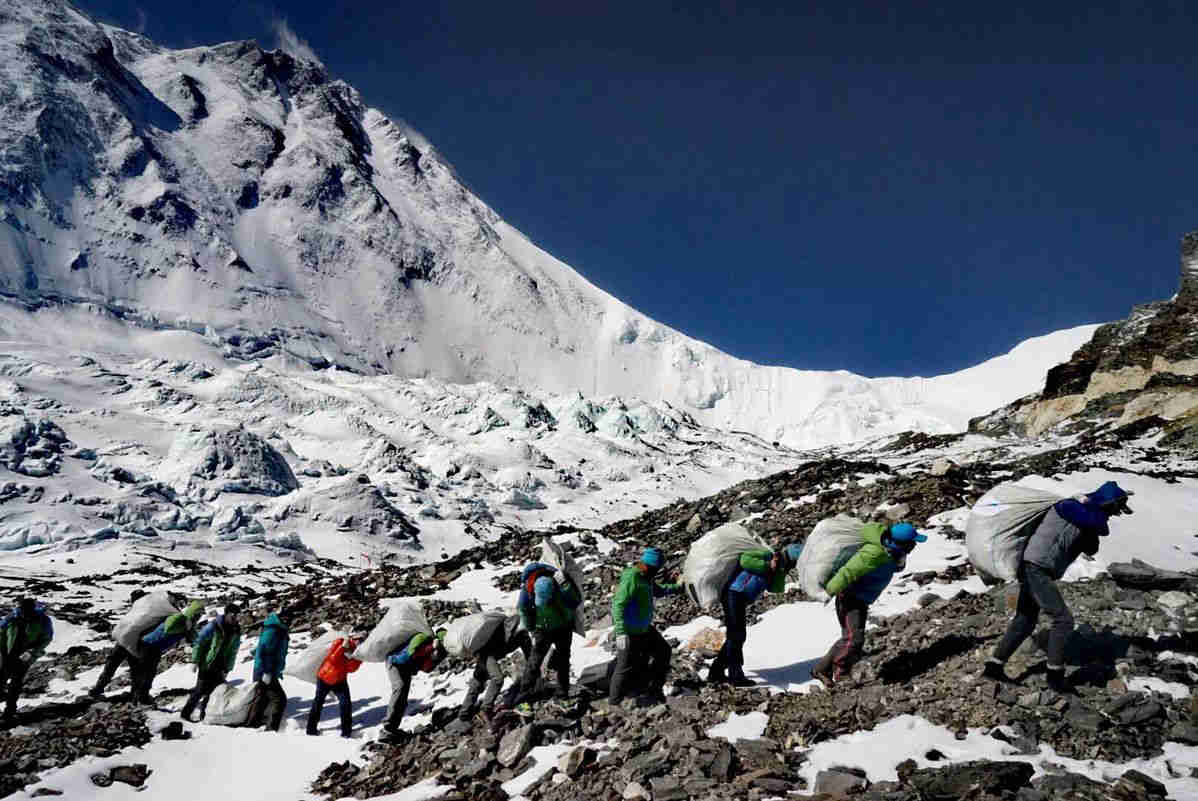


People carry garbage at an altitude of 6,500 meters on Qomolangma in Southwest China's Tibet autonomous region in May 2018. [Photo provided by the Tibet Himalaya Expedition Co for chinadaily.com.cn]
The ban on ordinary tourists entering the core zone of Qomolangma National Nature Reserve will not stop them from enjoying a full view of the mountain, as travelers can still reach Rongpo Monastery, a pilgrimage site 2 kilometers from the Qomolangma base camp, according to authorities in the Tibet autonomous region.
The reserve's 10,312-square-km core zone, home to one of the world's most vulnerable ecosystems, will continue to be open to mountaineers with climbing permits.
The region's Dingri county banned ordinary travelers in December from going to base camp, which lies at an altitude of 5,200 meters in the core area, for reasons of environmental protection.
However, the ban triggered some social media reports mistakenly saying that the Qomolangma base camp will be "permanently closed due to heavy pollution".
Kelsang, deputy director of the reserve's administration, told Xinhua News Agency that ordinary tourists are banned from areas above Rongpo Monastery, which is about 5,000 meters above sea level.
Though ordinary visitors can't go beyond the monastery, they can still see the mountain.
"The new tent camp for ordinary tourists allows them to clearly see the 8,800-meter-plus mountain," Kelsang said.
Qomolangma, known as Mount Everest in the West, has become a popular landmark for travelers in recent years. Visits reached 140,000 last year, with significant negative consequences to the environment from human behaviors, government authorities said.
Between April and October each year, residents of Dingri county set up black tents at the foot of Qomolangma to provide accommodations for tourists and earn money.
Chen Shougui, a 41-year-old nature reserve guide, said about 50 small camps were built at the altitude of 5,200 meters. Each of the camps can handle 20-plus travelers per day during the half-year active season.
"Masses of people left human waste and non-biodegradable trash behind. The site once looked like a dumping ground," said Chen, who supports the new policy.
"Actually, there is no difference for travelers in viewing the mountains from the monastery or the base camp, but the rush to the camp has resulted in heartbreaking damage to the reserve."
Three major cleanups were carried out by local guides and herdsmen at altitudes above 5,200 meters last year, with about 8.4 metric tons of waste collected, according to the government.
This year, the cleanup will continue, and the remains of deceased mountaineers above 8,000 meters will be dealt in a centralized way for the first time.
In addition to the limits on ordinary visitors, mountain climbers will also be placed under stricter scrutiny to reduce environmental impacts, Xinhua reported, citing Tibet's regional sports bureau.
Climbing activities will be limited to spring, with some of the revenues channeled to cleanup efforts, the report said.
 Fire brigade in Shanghai holds group wedding
Fire brigade in Shanghai holds group wedding Tourists enjoy ice sculptures in Datan Town, north China
Tourists enjoy ice sculptures in Datan Town, north China Sunset scenery of Dayan Pagoda in Xi'an
Sunset scenery of Dayan Pagoda in Xi'an Tourists have fun at scenic spot in Nanlong Town, NW China
Tourists have fun at scenic spot in Nanlong Town, NW China Harbin attracts tourists by making best use of ice in winter
Harbin attracts tourists by making best use of ice in winter In pics: FIS Alpine Ski Women's World Cup Slalom
In pics: FIS Alpine Ski Women's World Cup Slalom Black-necked cranes rest at reservoir in Lhunzhub County, Lhasa
Black-necked cranes rest at reservoir in Lhunzhub County, Lhasa China's FAST telescope will be available to foreign scientists in April
China's FAST telescope will be available to foreign scientists in April "She power" plays indispensable role in poverty alleviation
"She power" plays indispensable role in poverty alleviation Top 10 world news events of People's Daily in 2020
Top 10 world news events of People's Daily in 2020 Top 10 China news events of People's Daily in 2020
Top 10 China news events of People's Daily in 2020 Top 10 media buzzwords of 2020
Top 10 media buzzwords of 2020 Year-ender:10 major tourism stories of 2020
Year-ender:10 major tourism stories of 2020 No interference in Venezuelan issues
No interference in Venezuelan issues
 Biz prepares for trade spat
Biz prepares for trade spat
 Broadcasting Continent
Broadcasting Continent Australia wins Chinese CEOs as US loses
Australia wins Chinese CEOs as US loses